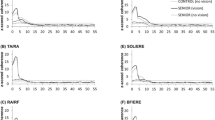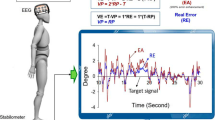Abstract
Sensory conflict impacts postural control, yet its effect on cortico-muscular interaction remains underexplored. We aimed to investigate sensory conflict’s influence on the cortico-muscular network and postural stability. We used a rotating platform and virtual reality to present subjects with congruent and incongruent sensory input, recorded EEG (electroencephalogram) and EMG (electromyogram) data, and constructed a directed connectivity network. The results suggest that, compared to sensory congruence, during sensory conflict: (1) connectivity among the sensorimotor, visual, and posterior parietal cortex generally decreases, (2) cortical control over the muscles is weakened, (3) feedback from muscles to the cortex is strengthened, and (4) the range of body sway increases and its complexity decreases. These results underline the intricate effects of sensory conflict on cortico-muscular networks. During the sensory conflict, the brain adaptively decreases the integration of conflicting information. Without this integrated information, cortical control over muscles may be lessened, whereas the muscle feedback may be enhanced in compensation.





Similar content being viewed by others
References
Macpherson JM, Horak FB. Posture. In: Principles of Neural Science, 5th ed. McGraw Hill, 2014: 935–958.
Keshavarz B, Riecke BE, Hettinger LJ, Campos JL. Vection and visually induced motion sickness: How are they related? Front Psychol 2015, 6: 472.
Fushiki H, Kobayashi K, Asai M, Watanabe Y. Influence of visually induced self-motion on postural stability. Acta Otolaryngol 2005, 125: 60–64.
Cheng Q, Li CT. Top-down modulation of outcome processing in primary sensory cortex for flexible behavior. Neurosci Bull 2021, 37: 889–891.
van Atteveldt N, Murray MM, Thut G, Schroeder CE. Multisensory integration: Flexible use of general operations. Neuron 2014, 81: 1240–1253.
Dokka K, Park H, Jansen M, DeAngelis GC, Angelaki DE. Causal inference accounts for heading perception in the presence of object motion. Proc Natl Acad Sci U S A 2019, 116: 9060–9065.
Shams L, Beierholm UR. Causal inference in perception. Trends Cogn Sci 2010, 14: 425–432.
Rohe T, Ehlis AC, Noppeney U. The neural dynamics of hierarchical Bayesian causal inference in multisensory perception. Nat Commun 1907, 2019: 10.
Ernst MO, Banks MS. Humans integrate visual and haptic information in a statistically optimal fashion. Nature 2002, 415: 429–433.
Fetsch CR, Turner AH, DeAngelis GC, Angelaki DE. Dynamic reweighting of visual and vestibular cues during self-motion perception. J Neurosci 2009, 29: 15601–15612.
Wang G, Yang Y, Wang J, Hao Z, Luo X, Liu J. Dynamic changes of brain networks during standing balance control under visual conflict. Front Neurosci 2022, 16: 1003996.
Liang T, Zhang Q, Liu X, Lou C, Liu X, Wang H. Time-frequency maximal information coefficient method and its application to functional corticomuscular coupling. IEEE Trans Neural Syst Rehabil Eng 2020, 28: 2515–2524.
Houston M, Li X, Zhou P, Li S, Roh J, Zhang Y. Alterations in muscle networks in the upper extremity of chronic stroke survivors. IEEE Trans Neural Syst Rehabil Eng 2021, 29: 1026–1034.
Conway BA, Halliday DM, Farmer SF, Shahani U, Maas P, Weir AI. Synchronization between motor cortex and spinal motoneuronal pool during the performance of a maintained motor task in man. J Physiol 1995, 489(Pt 3): 917–924.
Mendez-Balbuena I, Huethe F, Schulte-Mönting J, Leonhart R, Manjarrez E, Kristeva R. Corticomuscular coherence reflects interindividual differences in the state of the corticomuscular network during low-level static and dynamic forces. Cereb Cortex 2012, 22: 628–638.
Salenius S, Salmelin R, Neuper C, Pfurtscheller G, Hari R. Human cortical 40 Hz rhythm is closely related to EMG rhythmicity. Neurosci Lett 1996, 213: 75–78.
Brown P, Salenius S, Rothwell JC, Hari R. Cortical correlate of the Piper rhythm in humans. J Neurophysiol 1998, 80: 2911–2917.
Murayama N, Lin YY, Salenius S, Hari R. Oscillatory interaction between human motor cortex and trunk muscles during isometric contraction. Neuroimage 2001, 14: 1206–1213.
Pohja M, Salenius S. Modulation of cortex-muscle oscillatory interaction by ischaemia-induced deafferentation. Neuroreport 2003, 14: 321–324.
Marsden JF, Brown P, Salenius S. Involvement of the sensorimotor cortex in physiological force and action tremor. Neuroreport 2001, 12: 1937–1941.
Baker MR, Baker SN. The effect of diazepam on motor cortical oscillations and corticomuscular coherence studied in man. J Physiol 2003, 546: 931–942.
Riddle CN, Baker SN. Manipulation of peripheral neural feedback loops alters human corticomuscular coherence. J Physiol 2005, 566: 625–639.
Witham CL, Riddle CN, Baker MR, Baker SN. Contributions of descending and ascending pathways to corticomuscular coherence in humans. J Physiol 2011, 589: 3789–3800.
Tsujimoto T, Mima T, Shimazu H, Isomura Y. Directional organization of sensorimotor oscillatory activity related to the electromyogram in the monkey. Clin Neurophysiol 2009, 120: 1168–1173.
Ozdemir RA, Contreras-Vidal JL, Paloski WH. Cortical control of upright stance in elderly. Mech Ageing Dev 2018, 169: 19–31.
Liang T, Hong L, Xiao J, Wei L, Liu X, Wang H, et al. Directed network analysis reveals changes in cortical and muscular connectivity caused by different standing balance tasks. J Neural Eng 2022, 19. https://doi.org/10.1088/1741-2552/ac7d0c.
Huurnink A, Fransz DP, Kingma I, van Dieën JH. Comparison of a laboratory grade force platform with a Nintendo Wii Balance Board on measurement of postural control in single-leg stance balance tasks. J Biomech 2013, 46: 1392–1395.
Leach JM, Mancini M, Peterka RJ, Hayes TL, Horak FB. Validating and calibrating the Nintendo Wii balance board to derive reliable center of pressure measures. Sensors (Basel) 2014, 14: 18244–18267.
Paillard T, Noé F. Techniques and methods for testing the postural function in healthy and pathological subjects. Biomed Res Int 2015, 2015: 891390.
Costa M, Goldberger AL, Peng CK. Multiscale entropy analysis of biological signals. Phys Rev E 2005, 71: 021906.
Gow B, Peng CK, Wayne P, Ahn A. Multiscale entropy analysis of center-of-pressure dynamics in human postural control: Methodological considerations. Entropy 2015, 17: 7926–7947.
Delorme A, Makeig S. EEGLAB: An open source toolbox for analysis of single-trial EEG dynamics including independent component analysis. J Neurosci Methods 2004, 134: 9–21.
Mullen TR, Kothe CAE, Chi YM, Ojeda A, Kerth T, Makeig S, et al. Real-time neuroimaging and cognitive monitoring using wearable dry EEG. IEEE Trans Biomed Eng 2015, 62: 2553–2567.
Chang CY, Hsu SH, Pion-Tonachini L, Jung TP. Evaluation of artifact subspace reconstruction for automatic artifact components removal in multi-channel EEG recordings. IEEE Trans Biomed Eng 2020, 67: 1114–1121.
Peterson SM, Ferris DP. Group-level cortical and muscular connectivity during perturbations to walking and standing balance. Neuroimage 2019, 198: 93–103.
Shenoy Handiru V, Alivar A, Hoxha A, Saleh S, Suviseshamuthu ES, Yue GH, et al. Graph-theoretical analysis of EEG functional connectivity during balance perturbation in traumatic brain injury: A pilot study. Hum Brain Mapp 2021, 42: 4427–4447.
Pion-Tonachini L, Kreutz-Delgado K, Makeig S. ICLabel: An automated electroencephalographic independent component classifier, dataset, and website. Neuroimage 2019, 198: 181–197.
Van de Steen F, Faes L, Karahan E, Songsiri J, Valdes-Sosa PA, Marinazzo D. Critical Comments on EEG Sensor Space Dynamical Connectivity Analysis. Brain Topogr 2019, 32: 643–654.
Nguyen-Danse DA, Singaravelu S, Chauvigné LAS, Mottaz A, Allaman L, Guggisberg AG. Feasibility of reconstructing source functional connectivity with low-density EEG. Brain Topogr 2021, 34: 709–719.
Fuchs M, Drenckhahn R, Wischmann HA, Wagner M. An improved boundary element method for realistic volume-conductor modeling. IEEE Trans Biomed Eng 1998, 45: 980–997.
Zilles K, Zilles K, Amunts K. Centenary of Brodmann’s map—conception and fate. Nat Rev Neurosci 2010, 11: 139–145.
Baccalá LA, Sameshima K. Partial directed coherence: A new concept in neural structure determination. Biol Cybern 2001, 84: 463–474.
Niso G, Bruña R, Pereda E, Gutiérrez R, Bajo R, Maestú F, et al. HERMES: Towards an integrated toolbox to characterize functional and effective brain connectivity. Neuroinformatics 2013, 11: 405–434.
Akaike H. Citation Classic - a new look at the statistical-model identification. CC/ENG Tech Appl Sci 1981, 51: 22–22.
Horak FB, Macpherson JM. Postural orientation and equilibrium. In: Handbook of Physiology: Exercise: Regulation and Integration of Multiple Systems. Oxford University Press, 1996: 255–292.
Lipsitz LA. Dynamics of stability: The physiologic basis of functional health and frailty. J Gerontol A Biol Sci Med Sci 2002, 57: B115–B125.
Costa M, Priplata AA, Lipsitz LA, Wu Z, Huang NE, Goldberger AL, et al. Noise and poise: Enhancement of postural complexity in the elderly with a stochastic-resonance-based therapy. Europhys Lett 2007, 77: 68008.
Gruber AH, Busa MA, Gorton GE III, Van Emmerik RE, Masso PD, Hamill J. Time-to-contact and multiscale entropy identify differences in postural control in adolescent idiopathic scoliosis. Gait Posture 2011, 34: 13–18.
Lipsitz LA, Goldberger AL. Loss of ’complexity’ and aging. Potential applications of fractals and chaos theory to senescence. JAMA 1992, 267: 1806–1809.
Rideaux R, Storrs KR, Maiello G, Welchman AE. How multisensory neurons solve causal inference. Proc Natl Acad Sci U S A 2021, 118: e2106235118.
Airaksinen K, Lehti T, Nurminen J, Luoma J, Helle L, Taulu S, et al. Cortico-muscular coherence parallels coherence of postural tremor and MEG during static muscle contraction. Neurosci Lett 2015, 602: 22–26.
Fang Y, Daly JJ, Sun J, Hvorat K, Fredrickson E, Pundik S, et al. Functional corticomuscular connection during reaching is weakened following stroke. Clin Neurophysiol 2009, 120: 994–1002.
Takakusaki K. Functional neuroanatomy for posture and gait control. J Mov Disord 2017, 10: 1–17.
Takakusaki K, Takahashi M, Obara K, Chiba R. Neural substrates involved in the control of posture. Adv Robotics 2017, 31: 2–23.
Fetsch CR, Pouget A, DeAngelis GC, Angelaki DE. Neural correlates of reliability-based cue weighting during multisensory integration. Nat Neurosci 2011, 15: 146–154.
Yang Y, Dewald JPA, van der Helm FCT, Schouten AC. Unveiling neural coupling within the sensorimotor system: Directionality and nonlinearity. Eur J Neurosci 2018, 48: 2407–2415.
Acknowledgments
This work was supported by the National Defense Foundation Strengthening Program Technology Field Fund Project of China (2021-JCJQ-JJ-1029), the Science Technology Plan Project of Zhejiang Province (2023C03159), the Science Foundation of National Health and Family Planning Commission-Medical Health Science and Technology Project of Zhejiang Provincial Health (WKJ-ZJ-2334), and the key projects of major health science and technology plan of Zhejiang Province (WKJ-ZJ-2129).
Author information
Authors and Affiliations
Corresponding authors
Ethics declarations
Conflict of Interest
The authors declare that there are no conflicts of interest.
Supplementary Information
Below is the link to the electronic supplementary material.
Supplementary file2 (MP4 26518 kb)
Rights and permissions
Springer Nature or its licensor (e.g. a society or other partner) holds exclusive rights to this article under a publishing agreement with the author(s) or other rightsholder(s); author self-archiving of the accepted manuscript version of this article is solely governed by the terms of such publishing agreement and applicable law.
About this article
Cite this article
Wang, G., Yang, Y., Dong, K. et al. Multisensory Conflict Impairs Cortico-Muscular Network Connectivity and Postural Stability: Insights from Partial Directed Coherence Analysis. Neurosci. Bull. 40, 79–89 (2024). https://doi.org/10.1007/s12264-023-01143-5
Received:
Accepted:
Published:
Issue Date:
DOI: https://doi.org/10.1007/s12264-023-01143-5




